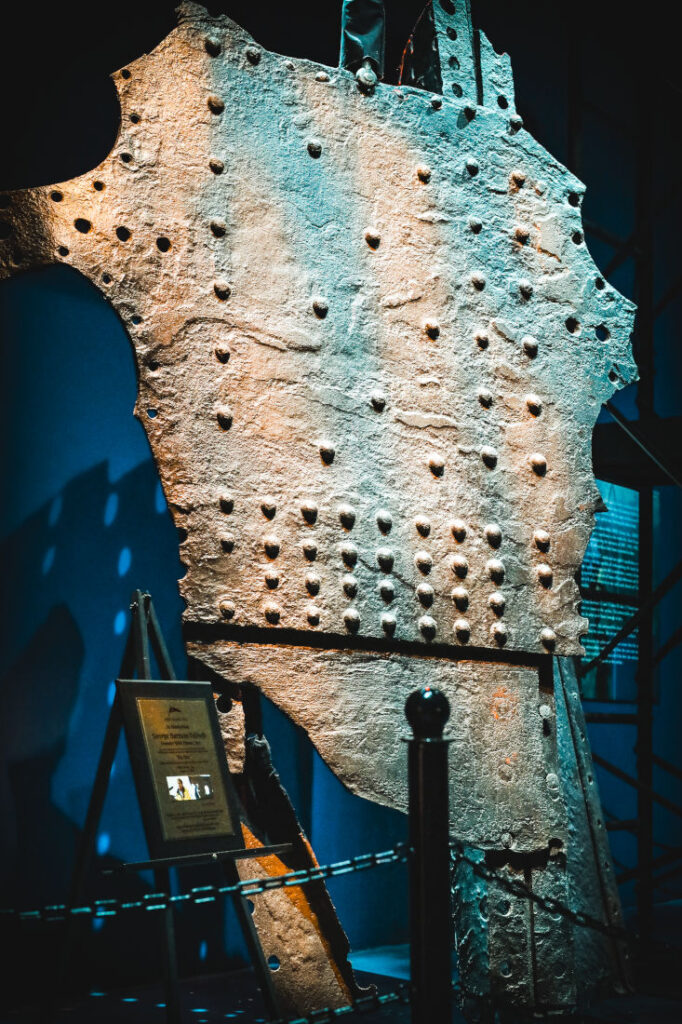 Did you know that over 5,500 artifacts have been carefully recovered from the wrecksite of Titanic? Each one tells a story, from elegant china to massive hull sections, and all are entrusted to RMS Titanic Inc. for ongoing care and preservation.
Did you know that over 5,500 artifacts have been carefully recovered from the wrecksite of Titanic? Each one tells a story, from elegant china to massive hull sections, and all are entrusted to RMS Titanic Inc. for ongoing care and preservation.
As the official steward of Titanic’s artifact collection, we have a simple but vital mission: to ensure that these objects, and the history they carry, are protected for generations to come. This means we don’t just recover and display them; we actively monitor, conserve, and maintain them for the rest of their lives.
What Happens After Recovery?
The moment an artifact is brought up from the ocean floor, conservation begins. That’s because objects that have spent decades deep underwater have adapted to their environment. Exposure to air can trigger corrosion or rapid deterioration, especially for materials including metal and wood.
So, we act fast. Each item is stabilized, cleaned, and treated based on its material and condition. Porcelain, for example, may just need gentle surface cleaning. But metals often require heavy-duty care, such as removing marine concretions or conducting a long desalination soak to remove harmful salt.
Behind this process is a team of expert conservators, each one trained in the care of specific materials. They catalog each piece, apply protective coatings, and track its condition over time. Many of these artifacts require periodic treatment throughout their lives.
A Closer Look: Conservation of Little Piece
This June, visitors to TITANIC: The Artifact Exhibition Orlando will have a rare opportunity to see this conservation work up close. One of the largest artifacts ever recovered from Titanic, called Little Piece, will undergo a full conservation treatment, right in front of the public.
So, what is Little Piece?
It’s part of a 17-ton section of Titanic’s hull, originally named “The Chunk,” that was discovered in the debris field in 1994. RMS Titanic Inc. launched one of its most ambitious recovery expeditions to bring it up, although it took two attempts (in 1996 and 1998) due to rough sea conditions. Once successfully recovered, the Chunk underwent an extensive multiyear desalination process, followed by years of conservation work.
Because of its massive size and irregular shape, the artifact later was divided into two parts for safe handling and to make display possible. These two artifacts are Big Piece, which resides in Las Vegas, and Little Piece, located in Orlando. Both have been on almost continuous display since recovery, where Exhibition guests from all over the world witnessed the desalination process. Little Piece even traveled to Europe and Australia before settling as a permanent fixture in Orlando, Florida. These artifacts now offer visitors a rare and powerful glimpse into Titanic’s scale and story as an engineering marvel of her time.
In 2022, Big Piece received its routine maintenance. Now it’s Little Piece’s turn.
What Will the Public See?
The conservation of Little Piece will be carried out by Evergreene Architectural Arts, the same team that performed its original treatment. Two professional conservators will be on-site, and the work will take place while the Exhibition remains open, so you’ll be able to witness this important process firsthand.
Here’s a brief overview of what the process includes:
- Clearing the surface of any dust and debris
- Gentle cleaning using a cleansing agent with special corrosion inhibitors
- Inspecting and treating for any corrosion
- Applying a protective wax coating to protect from elements
- Buffing and sealing the surface
- Documenting and photographing to monitor the artifact’s health over time
This nearly $20,000 project is part of our long-term commitment to responsible stewardship, and your visit helps make it possible.
Why We Conserve, Not Restore
A common question we hear is: “Why not restore the artifacts to their original state?”
The answer is rooted in respect both for history and for the story Titanic tells.
While restoration might make an artifact look new again, our goal is to conserve it as it is: shaped by time, tragedy, and the deep ocean. A gilded dish may look pristine, while a pipe may bear the scars of Titanic’s final moments. Both are equally important, and both deserve to be preserved honestly. By maintaining their current condition and halting further decay, we keep the story intact.
A Living Legacy
Titanic sank 113 years ago, but her story is far from over. Each artifact in our care offers a window into the past: to the grandeur of the Edwardian era, the human cost of the tragedy, and the continued fascination Titanic inspires around the globe.
Through active conservation, public exhibitions, and responsible storytelling, RMS Titanic Inc. works to honor this legacy. Our mission is to preserve Titanic’s history and honor the memories of those on board by ensuring these artifacts continue to tell their stories, not just in exhibitions, but to all who see them.
As our vision states:
- We envision a future when Titanic’s story continues to inspire curiosity, remembrance, and responsible exploration, fostering a global appreciation for maritime history and the lessons it imparts.
This summer, it continues with Little Piece.
